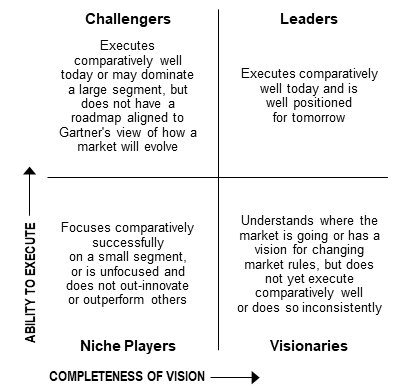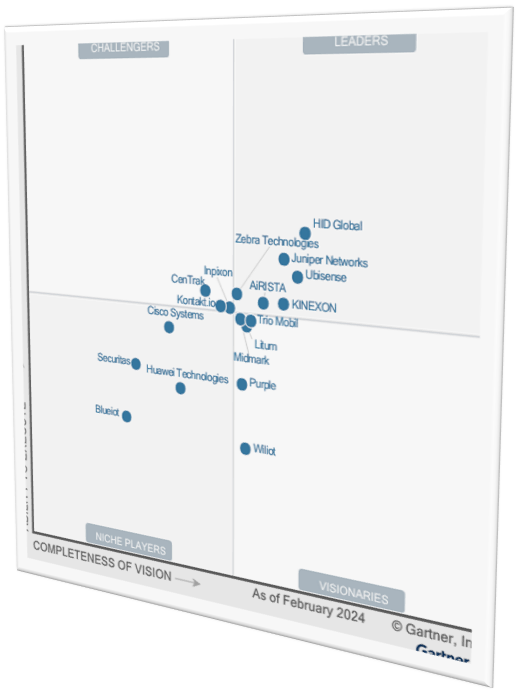The Gartner Magic Quadrant™ is an influential research tool that comprehensively analyzes various technology markets and the competitive positioning of the major players within these sectors. As a critical resource, the Magic Quadrant helps stakeholders—from C-suite executives to potential customers—understand the strengths and challenges of vendors, guiding informed decision-making in technology purchases and investments.
Developed by Gartner, a renowned industry analyst firm, this tool evaluates technology providers based on two key criteria: completeness of vision and ability to execute. The Magic Quadrant positions vendors within four quadrants—Leaders, Challengers, Visionaries, and Niche Players—each signifying different levels of performance and strategic vision in the industry. For example, “Leaders” excel in both their vision and execution, indicating they are well-positioned for the future and effectively meet current customer needs.
For companies, being evaluated and positioned on the Magic Quadrant can significantly impact their market visibility and credibility. It is a testament to a company’s strengths and can influence buyer choices in a crowded and competitive market. The annual updates provide insights into how positions change over time, reflecting market dynamics and company performance shifts.
Understanding the Gartner Magic Quadrant™ and its methodology is crucial for companies striving for recognition in their industry. It not only highlights where a company stands in comparison to its competitors but also provides valuable feedback that can drive strategic improvements and innovation.
Anatomy of the Gartner Magic Quadrant™
The Gartner Magic Quadrant™ categorizes technology vendors into four distinct quadrants based on their ability to execute and completeness of vision. These quadrants are labeled as Leaders, Challengers, Visionaries, and Niche Players, each representing a different type of market participant.
- Leaders are vendors who exhibit a robust ability to execute their vision and are well-positioned for the future. These companies have established market presence, a consistent track record of execution, and a clear vision for market direction. They are often the benchmark for other companies in the industry.
- Challengers possess strong execution capabilities but may lack the visionary aspect of the Leaders. These companies have the potential to outperform others and might dominate a large segment, but their strategies may need to be more innovative and forward-looking.
- Visionaries have a strong understanding of where the market is heading or have a vision for changing market rules, but they may struggle with implementation. These companies are often the ones to introduce new and transformative technologies or approaches.
- Niche Players focus successfully on a specific segment of the market, or a limited set of capabilities, rather than aiming to lead the overall market. While they may be excellent in their niche, their strategies do not have the breadth of the Leaders.
Understanding how companies are positioned within these quadrants based on Gartner’s rigorous assessment can offer significant insights into their market strategy, growth potential, and overall industry impact.

Benefits of Recognition as a Leader
Achieving a position as a Leader in the Gartner Magic Quadrant™ represents a significant milestone for any technology vendor. This status not only acknowledges a company’s robust market presence and well-rounded capabilities but also highlights its ability to shape industry trends and satisfy customer demands. Recognition as a Leader can offer multiple strategic advantages that propel business success and foster industry respect.
Being categorized as a Leader elevates a company’s reputation, enhancing its attractiveness to potential clients who are looking for reliable and industry-leading solutions. Customers are more likely to trust and invest in companies that Gartner identifies as Leaders because these organizations are perceived as safe and forward-thinking choices with a strong likelihood of sustained success.
Recognition as a Leader can significantly boost investor confidence. Investors seek businesses that hold a commanding market position and show a clear competency in executing their vision while continuing to innovate. This assurance often results in increased investments and financial backing, which can further accelerate a company’s growth and development initiatives.
Being a Leader in the Magic Quadrant can serve as a powerful marketing tool. Companies use their position in this esteemed category for promotional purposes, underscoring their industry authority and technological superiority. This can help in differentiating from competitors, attracting top talent, and entering new markets with a badge of excellence that is recognized globally.
The advantages of being recognized as a Leader in the Gartner Magic Quadrant™ are substantial, affecting various aspects of a company’s operations from strategic positioning to financial stability and market expansion.
Strategies for Success in the Gartner Magic Quadrant™
Achieving recognition in the Gartner Magic Quadrant™ is a coveted goal for technology vendors, as it can significantly elevate a company’s profile and influence in the industry. To position themselves successfully within this prestigious framework, companies must align their business strategies closely with Gartner’s evaluation criteria of completeness of vision and ability to execute. Here are some essential tips for companies aiming to enhance their standing in the Magic Quadrant.
Understanding Gartner’s Criteria:
First and foremost, companies must deeply understand the criteria Gartner uses to evaluate vendors. This includes not only the ability to execute—encompassing product or service viability, sales execution, and market responsiveness—but also the completeness of vision, which reflects market understanding, marketing strategy, and innovation. Companies should assess their current standing in these areas and identify areas for improvement.
Foster Innovation: Continuously evolve your offerings to meet current and future market needs. Innovation is a key component of vision completeness and can set a company apart from its competitors in the eyes of Gartner analysts.
Strengthen Customer Satisfaction: High levels of customer satisfaction and strong customer support are critical for a favorable evaluation. Companies should invest in customer service and support infrastructure, ensuring that customer feedback is integrated into product development and service enhancement.
Enhance Market Presence: Building a strong, recognizable brand and expanding market presence are vital. This involves effective marketing strategies, competitive positioning, and thought leadership that aligns with market trends and future directions.
Document Successes: Meticulously document and communicate the success stories and the value delivered to customers. This includes case studies, customer testimonials, and detailed performance metrics. These documents serve as evidence of a company’s ability to execute and fulfill its vision.
By strategically aligning their business practices with these guidelines, companies can improve their chances of not only being included in the Gartner Magic Quadrant™ but also achieving a favorable position within it. This recognition can be instrumental in guiding further growth and competitive advantage.
Leveraging Gartner’s Insights for Growth
Utilizing insights from Gartner, particularly those from the Magic Quadrant, can be a strategic lever for driving business growth. By incorporating Gartner’s analyses and recommendations, companies can refine their marketing and sales strategies, align better with market demands, and enhance their competitive positioning.
Strategic Decision-Making: Gartner’s insights provide a deep understanding of the market landscape, including key trends and buyer preferences. Companies can use this information to make informed strategic decisions, such as entering new markets, developing new products, or adjusting go-to-market strategies to better meet customer needs.
Marketing and Sales Alignment: The insights garnered from the Magic Quadrant can be powerful in shaping marketing and sales efforts. By highlighting a company’s strengths and areas for improvement, these insights can help tailor messages that resonate with target audiences, emphasizing proven capabilities and unique selling propositions identified by a trusted third-party analyst.
Enhance Credibility: Leveraging Gartner’s recognition in marketing materials can significantly enhance a company’s credibility. Featuring Gartner’s findings, such as being named a Leader or a Visionary, in promotional content can build trust with potential customers, showcasing the company’s industry acknowledgment and expertise.
Tailor Sales Strategies: Gartner’s feedback can help refine sales strategies by focusing on the key factors that influence purchase decisions in the industry. This may involve emphasizing certain product features, competitive pricing strategies, or customer success stories that align with Gartner’s observations.
Incorporating Gartner’s recommendations into business operations not only boosts external marketing and sales but also aligns internal teams towards common goals based on expert, objective analysis, thereby driving cohesive growth and innovation.
Building Credibility with Gartner Recognition
Gaining recognition from Gartner, especially being featured in the Magic Quadrant, can substantially bolster a company’s credibility and trustworthiness in the eyes of customers and industry peers. This type of endorsement serves as a powerful testament to a company’s market strength and reliability, which can have a profound impact on its reputation and perceived value.
Enhancing Customer Trust: Customers often look to authoritative sources like Gartner when making purchasing decisions. Being recognized by Gartner can reassure potential and existing customers of a company’s commitment to quality, innovation, and customer satisfaction. This recognition can help lower the perceived risk for buyers, making them more comfortable with investing in a company’s products or services.
Boosting Industry Standing: A Gartner endorsement can elevate a company’s status within its industry, positioning it as a leader or a significant challenger. This can attract attention from potential partners, investors, and talent, all of whom are critical to a company’s growth and success.
Marketing Leverage: Companies often leverage their Gartner recognition in marketing and sales materials. Highlighting Gartner’s endorsement can differentiate a company from its competitors, enhancing its appeal and supporting its claims of industry leadership and product superiority.
In essence, Gartner’s recognition not only supports a company’s external marketing efforts but also internally galvanizes confidence, providing a clear competitive edge in the market.

Leveraging AiRISTA for Business Success
AiRISTA’s recognition in the 2024 Gartner Magic Quadrant™ for Indoor Location Services underscores its leadership and innovation in providing advanced real-time location systems (RTLS). Moreover, this represents the third consecutive year that AiRISTA has been recognized as a leader. This acknowledgment highlights AiRISTA’s commitment to excellence and its ability to deliver high-value solutions across various industries. For businesses aiming to enhance operational efficiency and oversight, AiRISTA’s RTLS solutions offer a proven path to success.
Delivering Cross-Departmental Value: AiRISTA’s RTLS technology plays a pivotal role in transforming business operations by offering precise location tracking of assets, personnel, and equipment. This capability is crucial in environments such as healthcare, where it ensures that medical equipment and staff are optimally utilized, or in manufacturing, where it helps in managing inventory and streamlining workflows. The system’s versatility also extends to enhancing safety protocols by monitoring restricted areas and ensuring that safety equipment is readily available when needed. And in the event of a staff duress event, AiRISTA two-way communication tags help ensure a fast, coordinated response.
Enhancing Business Operations: Implementing AiRISTA’s RTLS solutions can significantly enhance operational efficiency within healthcare facilities. By reducing the time spent searching for critical medical equipment, healthcare providers can allocate their resources more effectively, minimizing delays and increasing time spent on patient care. Additionally, the data captured by AiRISTA’s systems can be used to analyze clinical workflows and identify bottlenecks, facilitating a more informed decision-making process that boosts productivity. This targeted approach not only streamlines operations but also improves patient outcomes by ensuring that vital healthcare tools are always at hand when needed.
Strategic Implementation: To fully leverage AiRISTA’s offerings, businesses should consider a strategic implementation plan that includes identifying key areas where real-time location data can have the most impact. Integrating AiRISTA’s RTLS solutions with existing enterprise systems can greatly enhance data visibility and operational responsiveness, particularly in tracking assets, inventory management, and optimizing logistics. Regular training sessions for staff to familiarize them with AiRISTA’s technology are crucial to ensure all employees can effectively utilize the system. Such measures will maximize the benefits derived from AiRISTA’s solutions, leading to improved efficiency and productivity in industrial operations.
By harnessing the power of AiRISTA’s innovative RTLS technologies, companies can achieve notable improvements in efficiency, safety, and overall operational intelligence. This leads to a stronger, more competitive position in the market, driven by data-driven decisions and optimized resource management.





